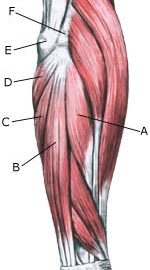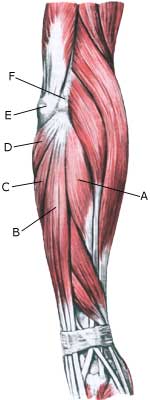TENNIS ELBOW
|
||
|
||
| Cause: The strength of the muscle fastening will be exceeded if subjected to repeated uniform (over)loads, causing microscopic ruptures in the tendon, and especially at the tendon fastening, resulting in an inflammation. This tendinitis is a warning that the training performed is too strenuous for the muscle tendons in question, and if the load is not reduced a chronic inflammation can arise which is problematic to treat. The condition is also called “tennis elbow”, and is often a consequence of incorrect stroke technique or unsuitable equipment (racket).
Symptoms: Tenderness and pain in the area of the outer bone projection on the elbow (epicondylus lateralis) which is aggravated when activating the muscle group which fastens there (backwards flexing of the wrist (extension) against resistance and when stretching). Acute treatment: Click here. Examination: The diagnosis is usually made based on a normal medical examination, however, if there are any doubts surrounding the diagnosis an ultrasound scan can be performed which will often reveal the inflammatory changes at the muscle fastening (article). With prolonged discomfort a fraying of the bone membrane (entesopatia) can be observed, as well as calcification of the soft parts which in places can have the characteristics of a calcaneal spur (Ultrasonic image). Treatment: Correction of stroke technique and adjustment of equipment are naturally vital elements for a successful rehabilitation. Treatment primarily comprises relief, stretching and strength training of the forearm muscles (article). If the discomfort does not abate, the treatment can be supplemented with medicinal treatment in the form of rheumatic medicine (NSAID) or injection of corticosteroid (article). During recent years, different types of experimental treatment have been seen such as sclerosis injection (where injections are performed around the tendon with a drug to destroy the small blood vessels (and nerves) that infiltrate the sick tendons), and shock-wave (ultrasound treatment). However, there is no sure or clear documentation for the effect of these kinds of treatment. Surgical treatment can be considered if there is no change for the better, however, the results are far from convincing. Bandage: Some patients experience an improvement in the symptoms by applying tape (or a bandage) around the forearm just below the elbow (tape-instruction). Complications: If satisfactory progress is not achieved it should be considered whether the diagnosis is correct or whether complications have arisen, which can amongst others be:
|


